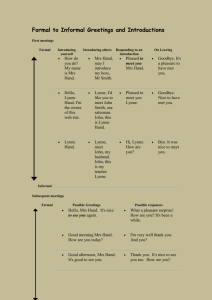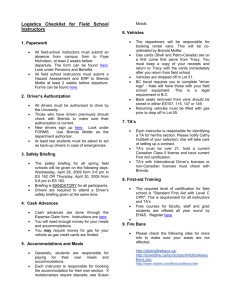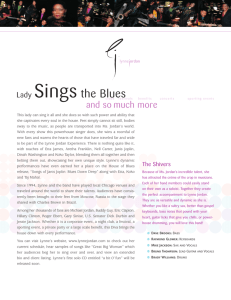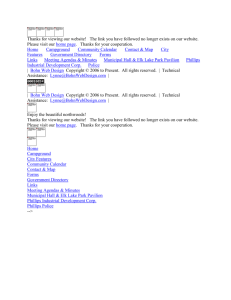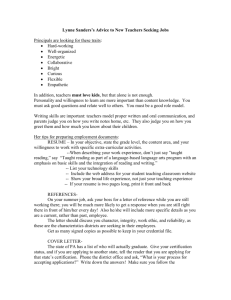Equality and Diversity – case studies template
advertisement
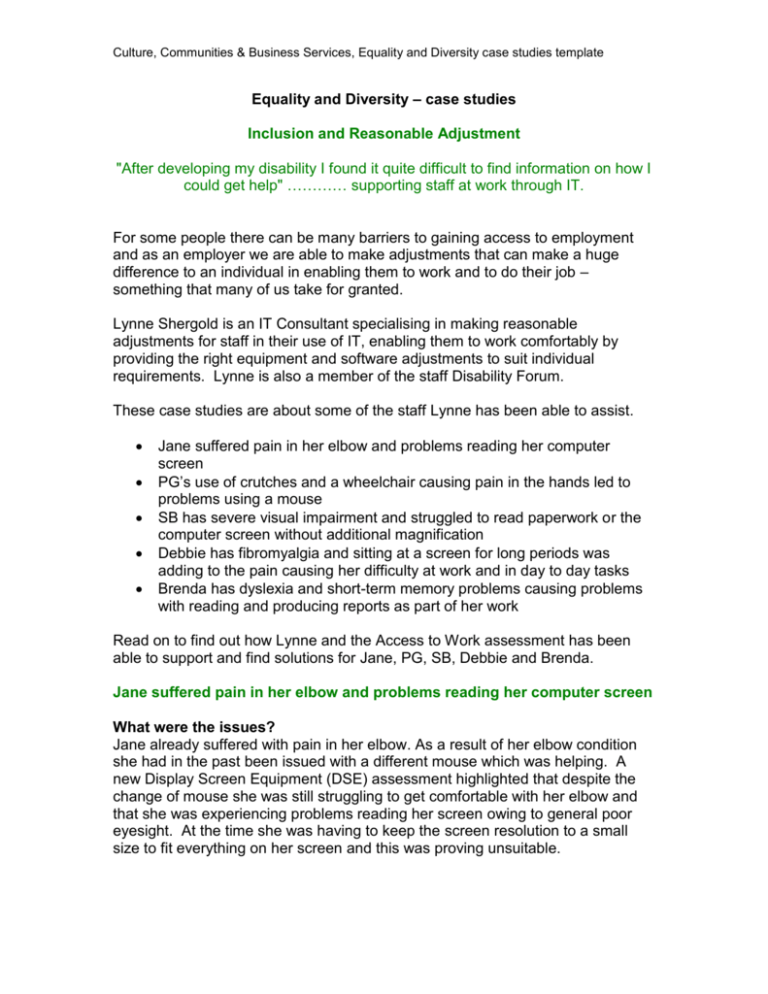
Culture, Communities & Business Services, Equality and Diversity case studies template Equality and Diversity – case studies Inclusion and Reasonable Adjustment "After developing my disability I found it quite difficult to find information on how I could get help" ………… supporting staff at work through IT. For some people there can be many barriers to gaining access to employment and as an employer we are able to make adjustments that can make a huge difference to an individual in enabling them to work and to do their job – something that many of us take for granted. Lynne Shergold is an IT Consultant specialising in making reasonable adjustments for staff in their use of IT, enabling them to work comfortably by providing the right equipment and software adjustments to suit individual requirements. Lynne is also a member of the staff Disability Forum. These case studies are about some of the staff Lynne has been able to assist. Jane suffered pain in her elbow and problems reading her computer screen PG’s use of crutches and a wheelchair causing pain in the hands led to problems using a mouse SB has severe visual impairment and struggled to read paperwork or the computer screen without additional magnification Debbie has fibromyalgia and sitting at a screen for long periods was adding to the pain causing her difficulty at work and in day to day tasks Brenda has dyslexia and short-term memory problems causing problems with reading and producing reports as part of her work Read on to find out how Lynne and the Access to Work assessment has been able to support and find solutions for Jane, PG, SB, Debbie and Brenda. Jane suffered pain in her elbow and problems reading her computer screen What were the issues? Jane already suffered with pain in her elbow. As a result of her elbow condition she had in the past been issued with a different mouse which was helping. A new Display Screen Equipment (DSE) assessment highlighted that despite the change of mouse she was still struggling to get comfortable with her elbow and that she was experiencing problems reading her screen owing to general poor eyesight. At the time she was having to keep the screen resolution to a small size to fit everything on her screen and this was proving unsuitable. Culture, Communities & Business Services, Equality and Diversity case studies template What did we do? Initially to assist with Jane’s vision her screen was set to a higher resolution but this then caused problems with seeing full screen options resulting in having to scroll around a lot. This further aggravated the elbow condition. Following the DSE Assessment, Jane contacted Lynne Shergold to see if she could assist with putting any specialist equipment in place for her. Lynne visited and discussed Jane’s issues and invited her to trial a mini keyboard which she found hugely beneficial. It enabled her to keep her hand closer to the side of her keyboard thus reducing the strain and pain in her elbow. Her 17” screen was swapped for a 20” screen which meant that she could still have the resolution high to aid reading but did not have to keep scrolling around to find items. Jane’s comments ….. After a DSE I was told to "find what you need and order it and I will authorise it" by my manager. The problem with that was I didn't know how, what or where! Along comes Lynne Shergold, I can sort that! Music to my ears! Let's try this, this and this and if that doesn't work we can progress to the next stage. The adjustments have worked resulting in time and money being saved – I didn't have to muddle my way through a system I don't know and money has been saved as it didn't get spent on equipment I didn't need. Within weeks I had all the equipment I needed to be able to continue my work comfortably. PG’s use of crutches and a wheelchair causing pain in the hands led to problems using a mouse What were the issues? PG had mobility issues which resulted in him having to use crutches or a wheelchair to get about. The knock on effect of this was the pain he was experiencing in his hands due to the pressure of walking on crutches or pushing the wheels on his wheelchair, this in turn was causing problems with using a mouse at work. PG had already completed a DSE Assessment but wasn’t sure where to go for further advice. What did we do? PG met Lynne Shergold via the Disability Forum. Lynne specialises in making reasonable adjustments to IT for staff and she was able to meet with PG and discuss his problems and suggest possible solutions. Lynne holds in stock several different types of mice and keyboards for staff who have been through a DSE or Access to Work Assessment to trial prior to committing to buying anything. This in the long run ensures that money is not wasted on equipment that will not be used and that the correct item is identified for each customer. Culture, Communities & Business Services, Equality and Diversity case studies template PG trialled approximately 4 different types of mice before he found the right one for him. The mouse PG required had to offer him certain functionality to do his job and be able to provide more comfort and flexibility in the way he worked. The mouse that PG opted for was a rollermouse station which can be used both left and right handed enabling him to alternate depending on the pain. PG’s comments ….. Due to problems with my hands I was finding using an ordinary mouse painful. My manager was happy for me to purchase a replacement but I had no idea what would be the best solution. Through the Disability Forum, Lynne was able to work with me to identify the best device for my needs. SB has severe visual impairment and was struggling to read paperwork or the computer screen without additional magnification What were the issues? SB has diabetic retinopathy which has resulted in severe visual impairment. This has had a major impact on SB being able to do his job with him struggling to read paperwork and computer screens without additional magnification. What did we do? SB contacted Access to Work for an Assessment and the assessment recommended that the following adjustments be made: Magnification Software Portable Day Light Lamp Desktop Magnifier Portable Magnifier Large Computer Screen Large Print Keyboard The Magnification software enables SB to magnify what he is reading on the computer screen and also has a reader function to read out what is on the screen. The portable daylight lamp allows SB to read handwritten material as he is able to control and focus his own light. To assist SB with reading printed and handwritten documentation a desktop video magnifier was purchased and also a portable version as SB works at different locations. The large print keyboard has the same size keys as a standard keyboard but the lettering is much bigger and bolder. SB’s comments ….. Prior to the adjustments made by Lynne my daily work was a real struggle, by the end of the day my eyes would be very tired and my day would always end with a headache. I am now far more comfortable with the tasks I have to carry out, and the overall package has greatly reduced the stress on my eyes. Culture, Communities & Business Services, Equality and Diversity case studies template For me a key element of the service Lynne provided was that she regularly consulted with me to see if the equipment provided was doing what it said on the tin, and has not just assumed that it was meeting the need. Whilst I still have to pace myself and work in fairly short bursts, the adjustments made have been invaluable in making me feel more confident in carrying out my daily tasks. My only regret is that I was not made aware earlier that this support from Access to Work and Lynne was available, as I feel it has had a major impact on my wellbeing. Debbie has fibromyalgia and sitting at a screen for long periods was adding to the pain and causing difficulty at work and in day to day tasks What were the issues? Debbie suffers with fibromyalgia (a condition that causes pain in muscles, ligaments, joints etc.) and her role requiring sitting at a computer for long periods of time was taking its toll. The impact on her work and general wellbeing meant that she was in constant pain and had increasing difficulty with both work and day to day tasks. Debbie applied to Access to Work for support in February 2012. What did we do? Access to Work arranged for an assessment to take place and made the following recommendations: Special Chair with Long Arms Voice Recognition Software (with training) Specialist Keyboard and Mouse Back Support Since the adjustments have been made she has found carrying out her duties much easier and is able to sit more comfortably when working. The voice recognition software enables Debbie to dictate reports and emails and therefore reduces the amount of time spent physically typing which she was finding increasingly uncomfortable. Debbie’s comments ….. After developing my disability I found it quite difficult to find information on how I could get help. My manager at the time searched Hantsnet and found a link for the Occupational Health Unit. After discovering this wasn't the right route to take, I was unable to find any more information. Following a transfer to a different department, my new manager was able to direct me to the Access to Work information on Hantsnet and an assessment was arranged. Culture, Communities & Business Services, Equality and Diversity case studies template Following my assessment, I was put in contact with Lynne Shergold in IT to discuss the recommendations made. Lynne was able to visit me in my workplace to install the equipment I needed and to discuss how best to use it. Lynne also installed the software I need to help me both in my office and at home where I work 2 days a week. Lynne arranged for the training I needed to use the software, and has been a great help with hints and tips to get the most from it. My manager was supportive throughout, and Lynne was able to guide us both through the process. The support I now have, plus some fairly simple adjustments to how and where I work have made an enormous difference to my wellbeing. Brenda has dyslexia and short-term memory problems causing problems with reading and producing reports as part of her work What were the issues? Brenda has dyslexia which had a huge impact on the written work that she had to produce for her role. The main areas that caused her problems were spelling, reading and taking notes. She also found that her short term memory resulted in her forgetting information that she wanted to include in reports and emails when she is typing them. This in turn meant that producing quality written documents could take a long time. Brenda found she had difficulty digesting information when reading it and that information was much easer to take in aurally. What did we do? In 2008 Brenda contacted Access to Work for an Assessment to find out if she was eligible for any support from them. They arranged for an assessment to take place and recommended the following adjustments: Voice Recognition Software Text to Speech Software Digital Dictation Machine Speaking Dictionary Mind Mapping Software Brenda – Launch Pad coordinator Access to Work also assisted with the costs of training to use the specialist software. This Voice Recognition software enabled Brenda to dictate rather than type reports and emails. This helped to reduce the impact of her condition by speeding up the transfer of her thoughts and ideas to screen as she found typing Culture, Communities & Business Services, Equality and Diversity case studies template very slow and felt her thought processes worked significantly in advance of her ability to type. The Text to Speech software enabled Brenda to have documents read to her rather than trying to read and digest them. It also provided a phonetic spell checker which recognises the unique spelling patterns of users with dyslexia and makes suggestions accordingly. The digital dictation machine would enable her to dictate notes either during or after meetings and then download them via the Voice Recognition Software to create MS Word documents rather than making written notes. The Speaking Dictionary is portable so Brenda is able to use it to support producing non computer based written work. The Mind Mapping software provided a valuable tool for organising and sequencing ideas. Many people with dyslexia struggle to organise thoughts in a written format and this software provides the facility to produce “visual idea maps”. Brenda’s comments ….. The software I obtained through Access to Work has made a great difference to my working day. I am now able to manage my workload in a more organised and less stressful manner. At the time of my assessment I had a new manager who was unfamiliar with Access to Work or anything to do with reasonable adjustments and didn’t know how to proceed. I found they were more concerned about how the process worked, the costs and any impact it may have to the running of the service. I was given Lynne Shergold’s name by one of her colleagues in IT and was advised she would be able to assist with my assessment. Having Lynne to contact directly I believe saved a lot time on emails & phone calls as she provided all the information my manager needed. The support I have received has been excellent and Lynne managed the whole process with great dignity and respect. This proved to be invaluable to myself and my manager in terms of progressing things. Having the same IT person makes it so much easier - you can contact Lynne with any questions you may have, she knows your background and knowledge of all the software you use and will help with any issues you may have. Lynne Shergold IT Consultant, Voice and Consultancy Team My name is Lynne Shergold and I work in the IT department as an IT consultant specialising in IT reasonable adjustments for people with disabilities. These could be minor adjustments such as a change of mouse or keyboard or more in-depth adjustments such as specialist software and equipment for people with dyslexia, visual impairment and hearing impairment. My IT background was in training and support and I came into this role by pure fluke. I was working in the equipment and network team for adult services and Culture, Communities & Business Services, Equality and Diversity case studies template my manager decided he wanted one person to focus on IT adjustments for staff who had either had a DSE assessment or Access to Work assessment. Originally I only provided support of this nature to staff in adults and children services but when the IT departments were restructured a couple years ago I moved into the central IT department and since then have been able to provide support to staff in all departments. When I first took on this role I had no idea what I was letting myself in for, I had not previously worked in this area of IT but felt I could bring something to the role and the rest I would learn as I went along. A huge part of the role is being able to listen and empathise with staff and their health/disability issues and the frustrations they experience in their working environment. Its about taking ownership of a problem and finding solutions. If a member of staff has had a DSE assessment and it is recommended they have a different mouse or keyboard I am able to provide loan mice and keyboards to staff to enable them to trial equipment before committing to buying anything. This has proved hugely successful in saving the council money on purchasing the wrong items. Although two members of staff might have the similar health issues the piece of equipment that each of them finds comfortable to use may be very different. This might be due to the way they work or their ability to adapt to a different item. Once the customer has trialled equipment and identified what works for them, if their manager is happy for me to have access to their sap ORG unit I am able to then raise the orders to purchase items. If a member of staff has been through an Access to Work Assessment I am able to provide advice and support with regards to any IT recommendations. I can manage the whole process including ordering, installation and claiming back any contribution from access to work. I have had basic training on most of the software packages recommended via access to work assessments and so am able to provide ongoing help and support to staff. As I've been doing this role for about six years I am really familiar with the equipment being purchased and am therefore able to advise and explain to staff what they will be getting prior to purchasing anything. I am able to advise on any limitations and restrictions with using specialist software with the Hantsnet environment and therefore manage expectations in terms of what they will and won't be able to do. If you would like any advice on specialist IT equipment or the access to work process I can be contacted either by my e-mail address: lynne.shergold@hants.gov.uk or by telephone (07841) 495272 For some examples of case studies – see the CCBS Equality & Diversity pages Email your completed case study to helen.wheeler@hants.gov.uk
